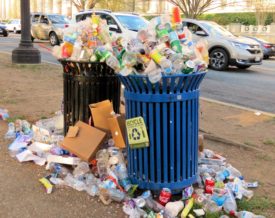
The bill basically says, “You can make and sell toxic electronic products, and you can buy them, but Washington’s taxpayers are no longer going to foot the bill for cleaning up your mess.” Put more diplomatically, it establishes a “shared responsibility” model, where those who enjoy the benefits of the transaction (the producer and buyer) are those who pay for its negative impacts. Or, as dad used to say, “You gotta pay to play.” Or mom, more to the point, “Go clean your room.”
This is how the Washington program will work:
-
In every county in the state, consumers (including residents, schools, charities, small businesses and small governments) can drop off their old monitors, computers and TVs at convenient no-charge collection centers, including retailers, non-profits, and local waste facilities. Retailers will be required to let buyers of new equipment know about the recycling centers, and the Department of Ecology will maintain an informational website.
- Manufacturers can either finance and set up an independent program, or participate in a standard program if they don’t want to set up their own. Regardless, each manufacturer will have to pay their “fair share” of the overall costs of the program based on their share of the products being brought to the collection facilities.
- The Department of Ecology will establish the processing standards that manufacturers must meet, and provide general oversight and enforcement.
Washington’s law is a great example of a policy solution that gets prices to tell the truth (at least to stop lying through their teeth, anyway), and it gives manufacturers ample incentive to design products that put safety first, causing fewer problems down the road.
Imagine you’re a manufacturer of a super cool electoxic. There are lots of things that determine how you design your product—features consumers want, how it looks on the shelf, what price point you’re trying to hit, what will get CNET reviewers raving, cost of materials, etc. But what it costs to dispose of your product at the end of its “useful” life (which is less than 5 years for a typical electronic product) has never entered your equation. Nor has the cost of the myriad health impacts your product contributes to.
Now imagine that you’re actually responsible for collecting and figuring out what to do with your toxic components. Not only do you have to collect, but you have to disassemble the products to extract the toxic stuff, and pay for the safe disposal of every pound of toxic. Talk about a great incentive to innovate!
Now this law is by no means perfect, and there’s still a lot to work out between now and 2009. But what I especially like about this approach is that it provides at least some pressure on both sides of the P&L for manufacturers. On the revenue side, demand for toxic products will drop because consumers won’t want to pay higher prices as the costs of recycling get passed on to them by the manufacturer. (Even better would be if buyers knew what share of the purchase price was going to pay for disposal of the toxics within. I can dream, right?) On the expense side, manufacturers will start to figure out ways to reduce their recycling and disposal costs, namely designing products that are easy to recycle and use fewer toxic components. And, because the manufacturers will be involved in the creation and management of the program, the feedback loop to the product design process will be much quicker than if they just had to pay an annual polluter fee like some other programs.
E-waste legislation is the hottest sector of the nascent “extended producer responsibility” or EPR policy category. According to the New York Times, 19 other states plus New York City currently have electronic waste bills pending. If you’re interested in learning more about EPR, check out the Product Policy Institute.
Kudos to Washington Citizens for Resource Conservation, WEC, and all the others who got the WA bill passed—with huge bipartisan support to boot.
And please, can anyone think of a better name for “extended producer responsibility?” I love this stuff, but that name makes even my eyes glaze over.






